Timeseries
Overview
Timeseries charts allow you to view the changes for a particular metric over time as a line graph or as a single number.
You can use these charts to answer questions such as "Is the average network request duration trending up or down?" and "Have my users been spending more time on a specific page over the past month?"
For each Timeseries type (other than Active User Count), you can create multiple "Comparisons" on a single chart which can be useful for comparing similar data points. Simply click "Add Filter" within the Comparing section and then "Add Comparison" to start comparing data!
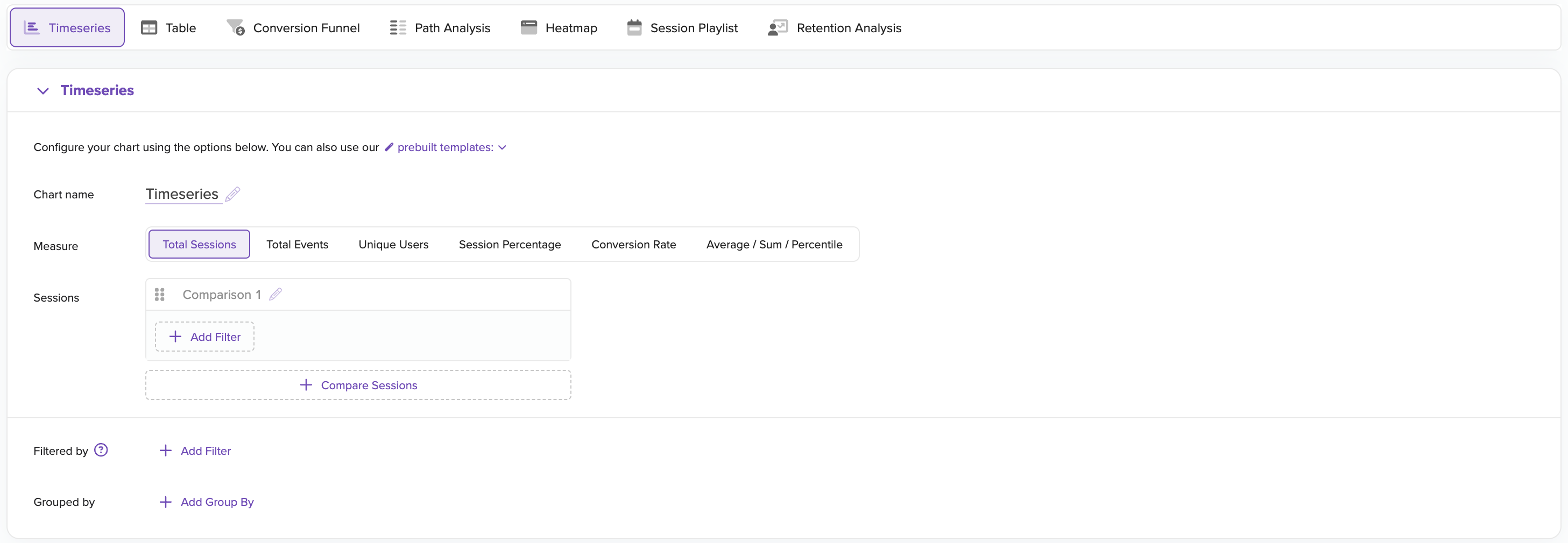
Timeseries options
Session Count
A Timeseries of Session Count will plot the number of sessions at each time interval over the selected period of time.
You can use filters on this chart to narrow down the category of sessions displayed in the chart. For example, if you are interested in seeing the number of sessions that visit a specific URL and are located in a specific country, you can add those filters below the selection of the chart type.
Group By
You have the ability to group a session count timeseries by a property using the '+ Add Group By' button. You can choose to group a timeseries by the following properties:
- Browser
- Country
- Device
- State/Region
- UTM Campaign
- UTM Medium
- UTM Source
- SDK Type
- Referrer
- Initial Visited URL of a Session
- Viewport Height
- Viewport Width
- Release
- Custom event property values
- User name
- User Traits
This breaks down a series by the different types within the property. You can also use the overall filter to define the data in more detail. For example, if you have a chart filter of "Clicked on text 'Home'" and apply a group-by property of 'Browser', you can see which Browser had the highest home page clicks. See below for an example.

Please note that group-by and multiple series are not supported together. If you have multiple series on a chart, you will be unable to add a group-by property.
Time Period Comparison
You can also compare a session count timeseries to the previous time period. Use the '+ Compare to' option in the top left when viewing the chart. The previous time period will be visible as a dotted line on the chart:
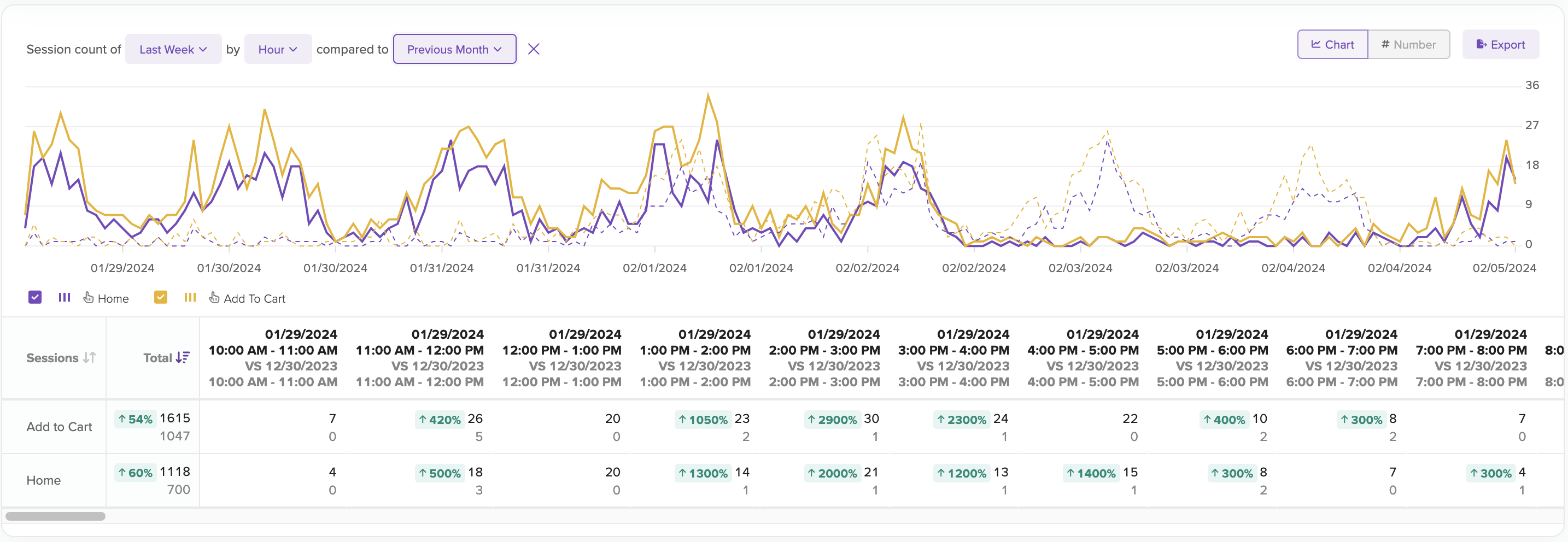
Please note that Group By and comparison time ranges are not supported together. If you have a comparison time range enabled, you will be unable to add a Group-By property.
Export
You can export the data shown in the timeseries to a CSV file. Use the 'Export' option in the top right when viewing the chart. This will export all series or group-by data for the primary and comparison time ranges.
In the exported CSV, the data is ordered by date. For intervals that are the same between the primary and comparison range, there will only be a single column with the overlapping date ranges.
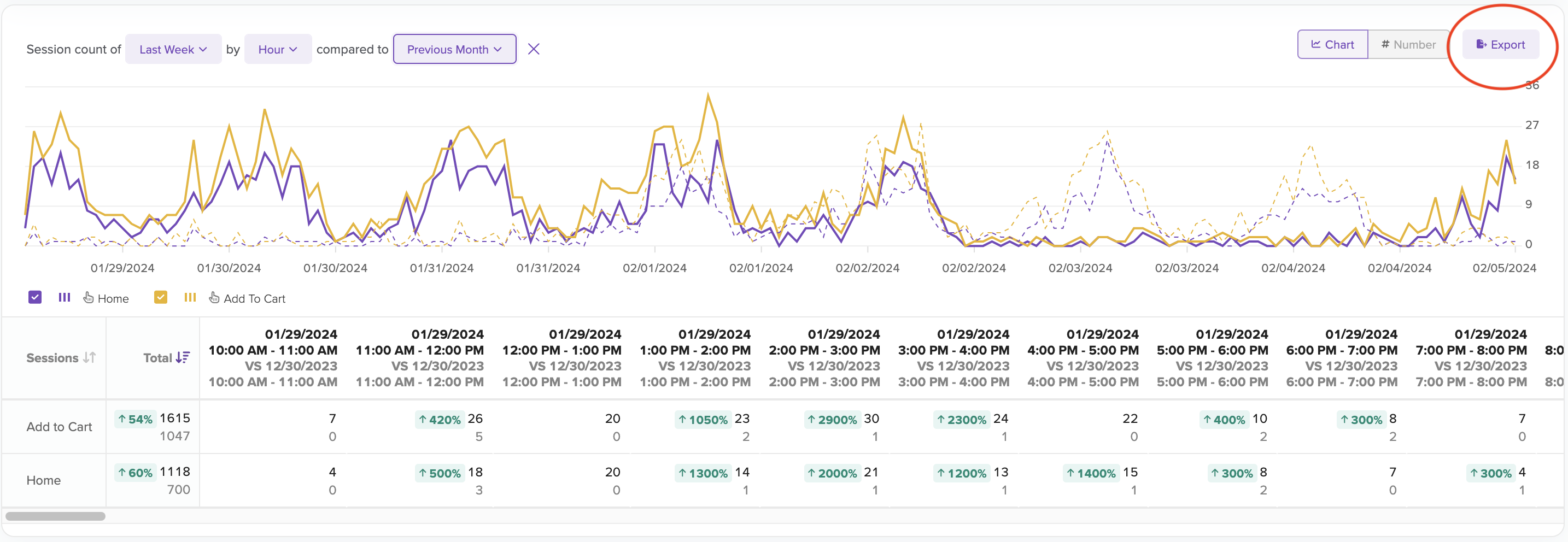
Event Count
A Timeseries of Event Count will plot the number of events at each time interval over the selected period of time.
Currently we support Custom Events, Clicks, Page Views (Visited URLs) and Definitions for this timeseries type. The session list below the timeseries shows sessions relevant to each time interval, but the numbers displayed within the chart are the number of events rather than the number of sessions.
Group By
You have the ability to group an event count timeseries by a property using the '+ Add Group By' button. This breaks down a series by the different group-by values. In doing so, you can answer valuable questions like "Which UTM Campaign was most associated with users that clicked our 'Start a Trial' button?"
You can choose to group the events by the following properties of the session in which they occurred:
- Browser
- Country
- Device
- State/Region
- UTM Campaign
- UTM Medium
- UTM Source
- Referrer
- Landing Page
- Viewport Height
- Viewport Width
- Release
Or properties of the users associated with the session where the event occurred:
- User name
- User Traits
Or by properties of the events themselves:
- Property values of the custom event
- URL of the click event
For example, imagine we have a "Purchase" custom event with a property for the purchased item's cateogry, such as "Clothing." With the event count group bys, we can see how many purchases of each category are happening each week.
Please note that group-by and multiple series are not supported together. If you have multiple series on a chart, you will be unable to add a group-by property.
Unique Users
A timeseries of Unique Users allows you to keep track of the number of unique active users of your application within the timeframe of your choice.
You can apply a filter to this chart type to define "active" in a way that makes sense for your application. For example, if you're interested in measuring the number of Daily Active Users that visit a certain page on your site, you can add the 'Visited URL' filter to this chart.
Percentile / Sum / Average
This timeseries allow you to view percentiles, sums, and averages for various types of data and plot them over time.
The available options include measurements of frontend performance within the application, such as Time Between Events and Network Request Duration, as well as user behavior metrics such as Time on Page.
For percentiles, you can choose to view the 50th, 90th, 95th, and 99th percentile levels for each type of measurement. Each level of percentile will give you different insight into the data points. For example, if you are interested in the average amount of time that users are spending on a page, you can choose to view the 50th percentile of the Time on Page metric. Or if you want to keep track of the performance of your network requests, you can use something like the 95th percentile to know that 95 percent of your network requests have a duration that is lower than what is displayed on the graph.
Sum is useful when combined with custom events that track revenue in order to understand the total revenue being generated in a week or month.
Average allows you to see the average time users are spending on a given page in a session and/or how long, on average it takes users to go from step 1 to step 2 in a funnel.
Conversion Rate
A timeseries of Conversion Rate allows you to keep track of the historical conversion rate between two pages or steps over time.
Similar to the funnels, you can define specific steps based on click events, URL visits, and redux actions and view whether the conversion rate has been increasing or decreasing over time (specifically, whether users who completed the first step also completed the second step). This can give you insights into historical trends and whether, for example, specific marketing pushes or technical efforts have affected the conversion.
Session Percentage
The Session Percentage timeseries allows you to measure the number of sessions that have completed a certain action or fit a certain category (defined by the use of filters) and display it as a percentage of the total sessions at any specific point in time.
Number View
View any Timeseries as a single number to display on your dashboard.

The number displayed is the value of the most recent complete interval, and it shows a comparison with the value of the interval before that.
For example, if you are viewing a Timeseries chart with a time range set of 1 week, and the interval is set to hourly, switching to the Number view will show you the value of the Timeseries in the most recent complete hour.
Time Range & Interval Settings
You can select the time range and interval for a timeseries and save the selection with the chart. For example, you may choose to see a count of users that were active in the last month by week.
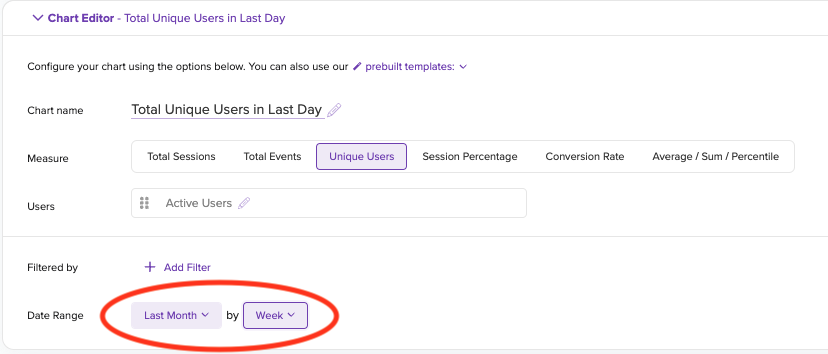

Alternatively you can use the "Entire Range" option to see the total count for the entire time range. The total count is also exposed in the "Total" column for easier access.
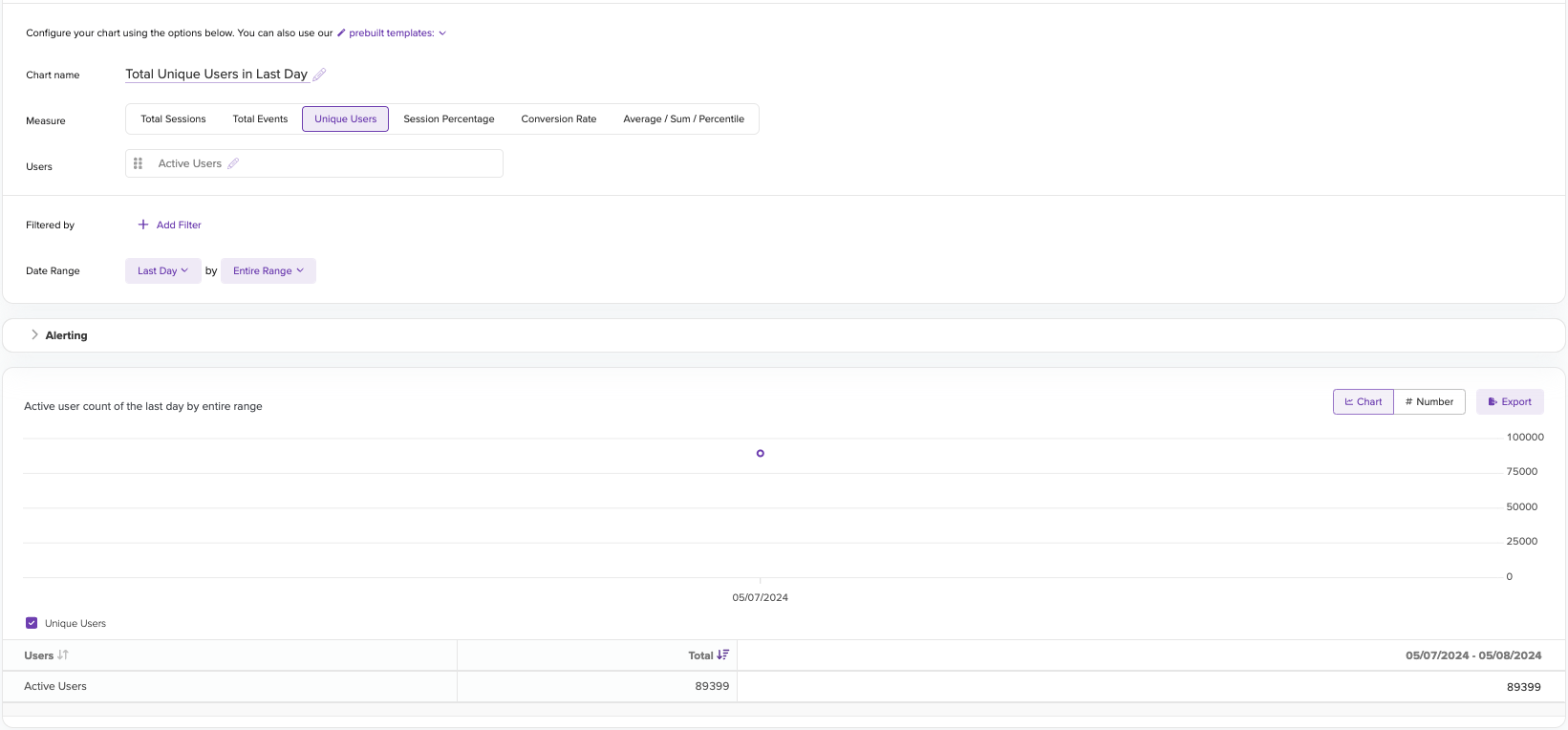
Timeseries Insights
LogRocket can provide some proactive insights about some of your Timeseries charts. For more information, see Timeseries Insights.
Updated 3 months ago
